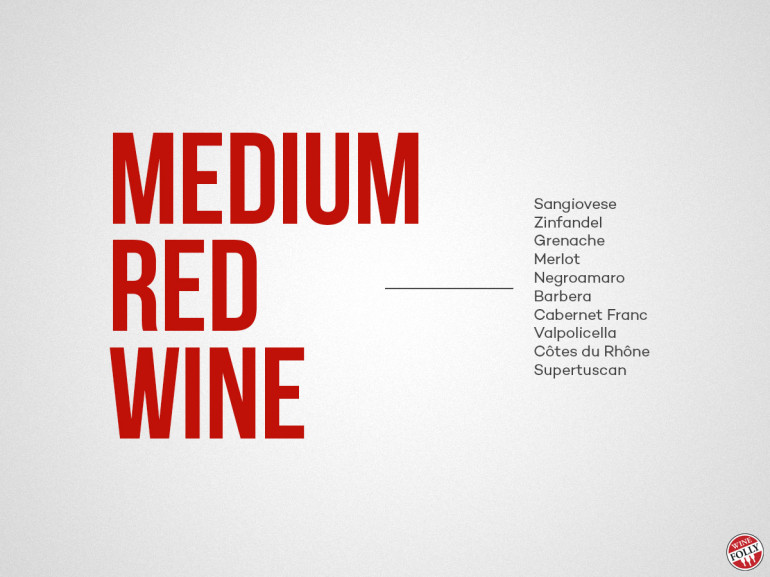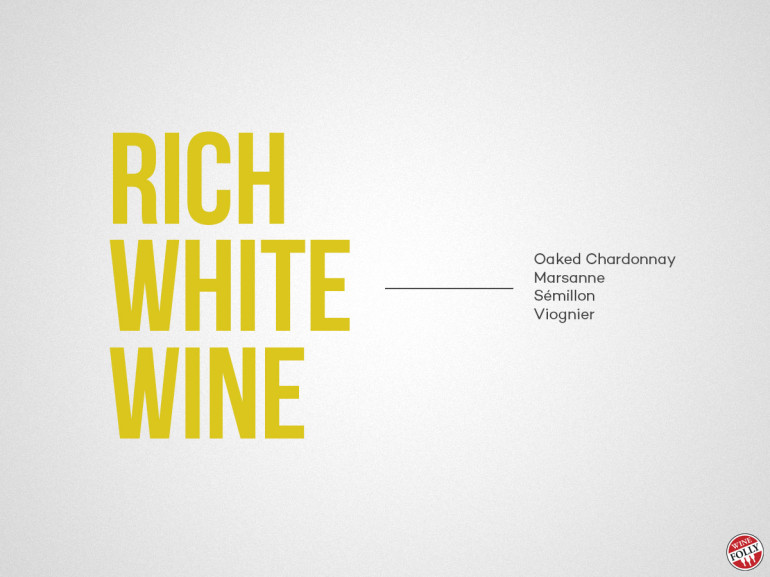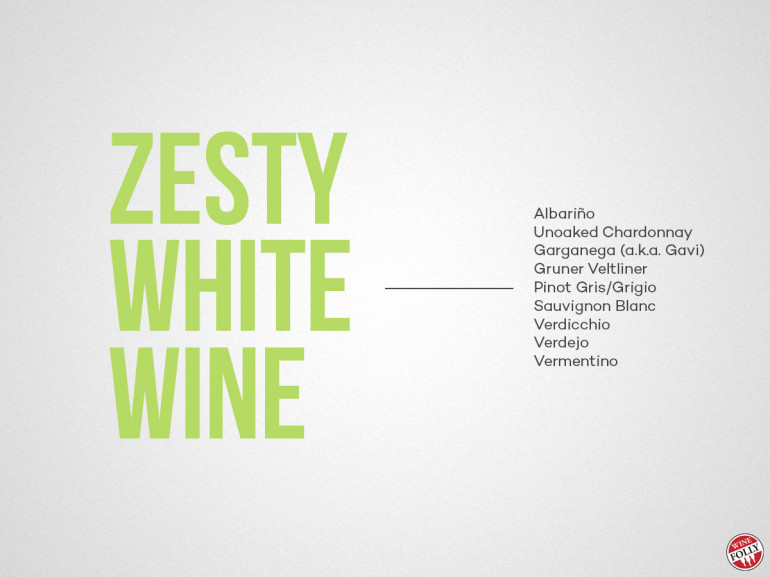Ever find yourself looking at a wine list, wanting a specific type of wine, but don’t know how to ask for it? Learning how to order wine is as simple as having a good understanding of just 9 wine styles. If you’re already very familiar with the styles listed below, check out the continued learning at the bottom of each style.
9 Primary Wine Styles
Traditionally, there are two ways to understand wines: by variety (e.g. Sauvignon Blanc or Syrah) or by region (e.g. Barossa or Bordeaux). This approach is very accurate, but requires a lot of learning. Fortunately, you can start classifying grape varieties by these 9 broader styles which will make learning about the thousands of wine varieties and regions much easier. Most wines fit into 9 major categories that include all red, white, rosé, sparkling and dessert wines.

The 9 Styles of Wine
- Full-Bodied Red Wines
- Medium-Bodied Red Wines
- Light-Bodied Red Wines
- Rosé Wines
- Full-Bodied White Wines
- Light-Bodied White Wines
- Aromatic White Wines
- Dessert & Fortified Wines
- Champagne & Sparkling Wines
Full-Bodied and Rich Red Wines
Full-bodied wines typically have more tannin, higher alcohol, and dark fruit flavors such as black currant. Since these wines have so much pigment, they are higher in anthocyanin which has shown positive benefits to cardiovascular health. As far as flavor, these wines are the biggest on the spectrum and thus, pair with equally bold-flavored food. Typically you’ll find them served in large-bowled wine glasses.
Examples
- Syrah
- Cabernet Sauvignon
- Monastrell
- Malbec
- Montepulciano
- Aglianico
- Dolcetto
- GSM blends (such as Côtes du Rhône)
- Petite Sirah
- Nebbiolo
- Tempranillo
- Nero d’Avola
- Sagrantino
- Tannat
- Zinfandel
Serving Temperature
Room Temperature (63-69 °F / 17-21 °C)
Food Pairing Affinities
Barbecue, Mexican Foods, Smoked Meats, Red Meat & Steaks, Savory Mushroom Dishes, Black Pepper
Continued Learning
Medium-Bodied and Textured Red Wines
In the middle of the gamut from light to full, medium-bodied reds are some of the best food-friendly wines. Classic examples of this style include varieties like Sangiovese and Merlot. Wines made from these varieties can be somewhat variable in style because of regional differences in growing and winemaking. For instance, a Merlot from a hillside estate on Spring Mountain in Napa Valley will have high tannin and darker fruit flavors whereas a Merlot from a large valley vineyard in Lombardy, Italy will probably exhibit fewer tannins and soft red fruit aromas.
Examples
- Sangiovese
- Grenache
- Merlot
- Negroamaro
- Barbera
- Cabernet Franc
- Valpolicella Wines
Serving Temperature
Room Temperature (63-69 °F / 17-21 °C)
Food Pairing Affinities
Lasagna, Pizza with Red Sauce, Spiced and Roasted Meats, Hearty Vegetable Soups, Hamburgers, Roasted Vegetables, Strong flavored spices like Cinnamon, Fennel, Anise, Cumin, Rosemary, Chili Pepper, Allspice
Light-Bodied Red Wines
Delicately perfumed with very subtle flavors, light-bodied red wines are perfect for people who don’t want to get knocked upside the head with their wine. both collectors and beginners alike enjoy the approachable nature of these wines. Light red wines are known for having lighter tannin, bright acidity and slightly lower alcohol with red fruit flavors. They are classically served in a fish-bowl-type glass that collects the aromas.
Examples
- Pinot Noir
- Cinsault
- Gamay
- Ciliegiolo
- Freisa
- Schiava
- Brachetto
Serving Temperature
Cool Room Temperature (53-63 °F / 12-19 °C)
Food Pairing Affinities
Mushroom Risotto, Coq au Vin, Cream Pasta with Chicken, Chicken & other Poultry
Continued Learning
Rosé Wines
Rosé wines are the literal mid-point between white and red wine, however they tend to behave a lot more like a white wine. They are typically served chilled and many are dry (save for a few). This style of wine is frequently produced in the Mediterranean around the south of France, islands in the Mediterranean, the Spanish eastern coast and in Italy. Expect to spend anywhere from about $12-17 for a great-tasting rosé.
Examples
Serving Temperature
Cool Room Temperature (53-63 °F / 12-19 °C)
Food Pairing Affinities
Spice Route Dishes, Fried Chicken, Roast Pork, Mexican Food, Lebanese, Greek and Turkish Cuisine
Full-Bodied and Rich White Wines
Full-bodied white wines have often been confused with red wines when served in black glassware. Rich white wines typically undergo similar treatments as red wines in the winery to achieve the bold flavor, and thus have some flavor similarities. Typically, many rich whites undergo oak aging, to add that classic vanilla or coconut note, as well as a process called “Malolactic Fermentation”, which changes the type of acid in the wine to make wine taste creamier. Many full-bodied white wines will age up to 10 years, although most are in their prime at around 3-4 years. Expect to spend about $17+ for a decent rich white wine.
Examples
- Oaked Chardonnay
- Sémillon
- Viognier
- Marsanne
Serving Temperature
Cool (44-57 °F / 7-14 °C)
Food Pairing Affinities
Crab & Lobster, Pasta with Cream Sauce, Tarragon Chicken, White Pizza, Cashew Cream, Soft Cheeses, Chicken & Other Poultry
Light-Bodied Dry White Wines
Like a lightning bolt in your mouth, whites in this style are the wine equivalent to a lager; they’re good because they’re refreshing. “Dry”, “Crisp” “Tart” and “Zippy” are all synonymous with “zesty”. They’re usually best enjoyed young, within a year or two of the vintage, to preserve the fresh fruity flavors and mouth-watering acidity. Of all the wine styles, dry and crisp whites often have the best bang for the buck, with great examples available for around $10 . Of course, you can find some extremely badass higher-end options, if this style is your thing.
Examples
- Albariño
- Unoaked Chardonnay
- Garganega (a.k.a. Soave)
- Grüner Veltliner
- Pinot Gris/Pinot Grigio
- Sauvignon Blanc
- Verdicchio
- Verdejo
- Vermentino
Serving Temperature
Cold (44-57 °F / 7-14 °C)
Food Pairing Affinities
Seafood, Sushi, Green Salads, Pesto, Fried Foods (like French Fries and Fried Chicken), Chicken & other Poultry
Aromatic White Wines
Perfumed fruit and floral aromas fly out of your glass with these wines. They’re often (but not always) made in a style with some residual grape sugar. However, much like good lemonade, this sweetness is generally used to balance an aggressive acidity or bitterness in the wine. The sugar is there for balance, not just for the sweetness’s sake. Without retaining a little naturally-occurring grape sugar, many of these wines would be far too bitter or acidic for most drinkers. This style of wine is often referred to as, “harmoniously sweet”.
Remember, sweetness isn’t inherent to certain grapes, because leaving sugar in a wine is a wine-making decision, rather than a prerequisite of a given grape. Any type of grape can be made dry, including those you may generally associate with sweet styles. Riesling is the foremost example of this. You can’t smell sweetness. You can smell aromas you associate with sweet flavors, but until you take a sip, there’s no way to know whether the wine is sweet or dry. These grapes below are great to train your palate on the difference between sweetness (a taste) versus fruitiness (an aroma).
Examples
- Chenin Blanc (both dry and sweet styles)
- Gewürztraminer (both dry and sweet styles)
- Muscat Blanc (a.k.a. Moscato) (usually sweet, made occasionally in a dry style)
- Riesling (both dry and sweet)
- Torrontés (typically made in a dry style)
Serving Temperature
Cold (44-57 °F / 7-14 °C)
Food Pairing Affinities
Indian Cuisine, Thai Food, Citrus-driven Dishes, Pungent Cheeses, Cream Sauce, Cake, Ice Cream
Dessert & Fortified Wines
In order to preserve the natural sweetness in fortified wines, the fermentation is stopped before the yeast gobbles up all the sugar. Typically when you do this, you’d be left with a lower alcohol wine but since fortified wines are allowed to add spirits (in the form of a neutral-tasting grape brandy) the wines are usually around 17-20% ABV. Because of the high alcohol and sugar content, dessert wines are precious and meant to be enjoyed in small amounts (about 2-3 ounces) in tiny glasses. Of course, there are many more options in the dessert wine category other than just fortified wines (i.e. Sherry, Madeira and Port. Sauternes). Tokaj, late-harvest Loire Valley Chenin Blanc and many more are what you would call “naturally sweet” dessert wines. Their sugars are usually concentrated by some sort of dehydration, rather than the addition of alcohol. Find out more about dessert wines.
Examples
Serving Temperature
Varies
Food Pairing Affinities
Pungent Cheeses (like Blue), Caramel, Cakes, Chocolate, Fruit Pies
Champagne & Sparkling Wines
The secret to Champagne bubbles comes from the addition of a special mixture of sugar and yeast called the ‘liqueur de tirage’ to a dry, still base wine. The liqueur de tirage induces a second fermentation in the bottle; this makes the bubbles. Although, not all Sparkling wines are made in this way. Most notably Prosecco and Lambrusco are made by fermenting the wine in a tank under pressure and then bottling from there. Low-quality sparkling wines are often force-carbonated. Sparkling wines have bubbles and high acidity and range from white, rosé to red in color. Sparkling wines have been long associated as a celebratory beverage, but actually match with a wide variety of foods.









